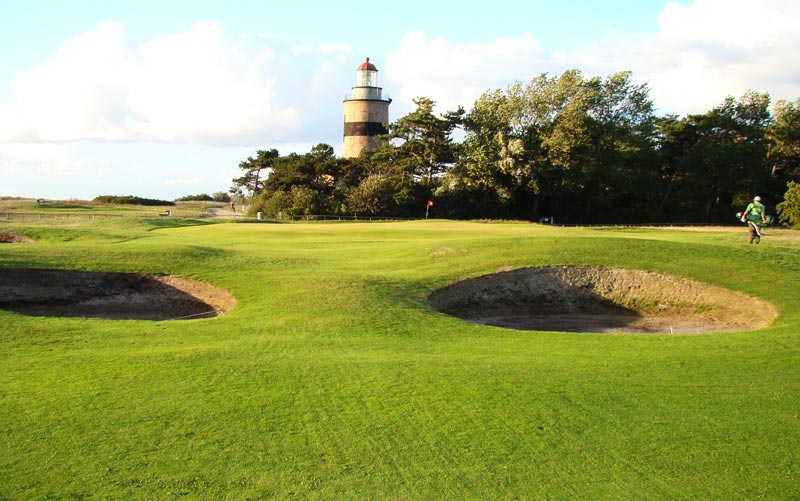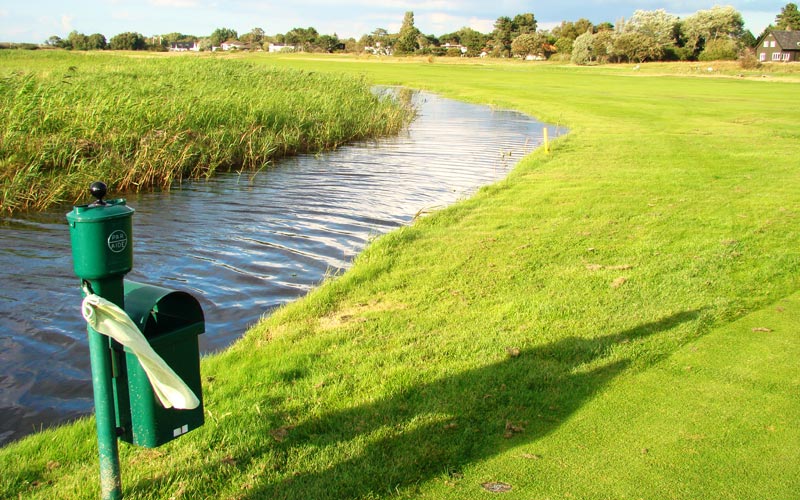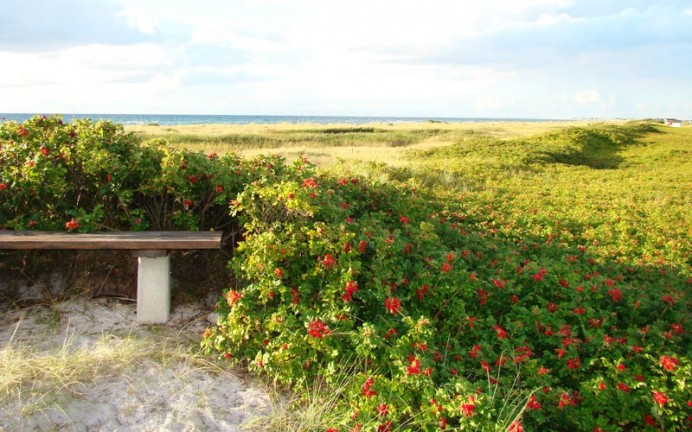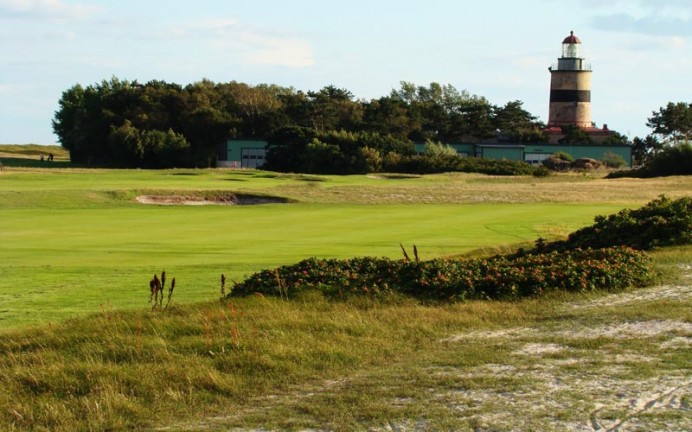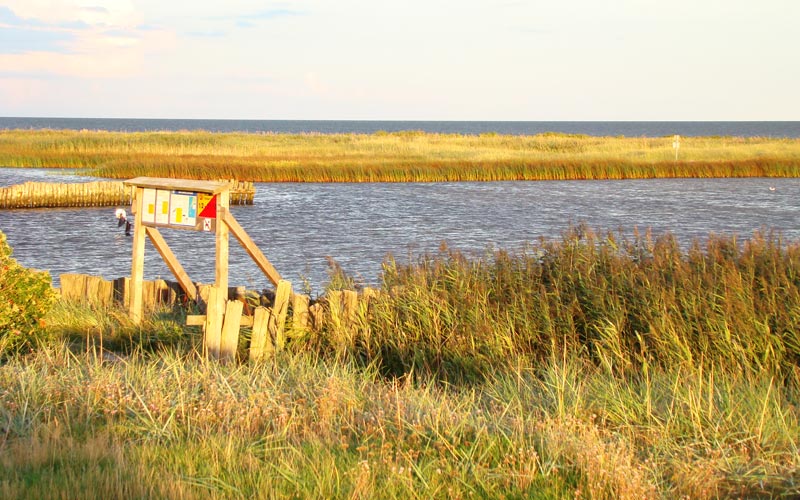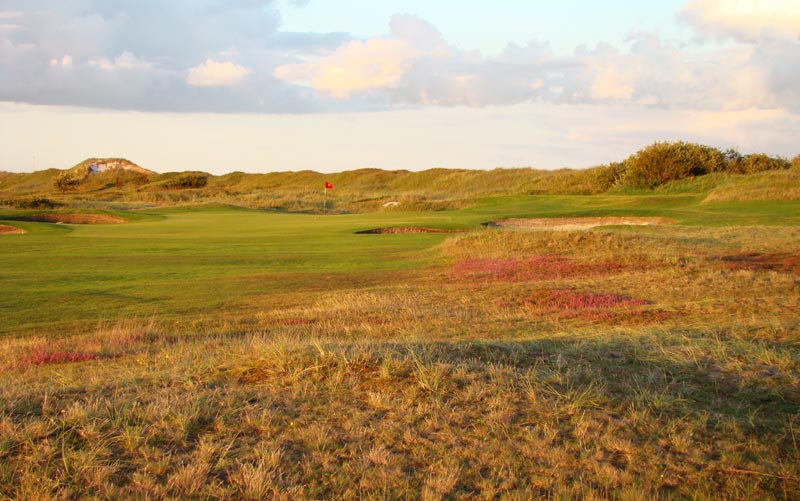Falsterbo GolfKlubb
Falsterbo, Sweden
Golfers have been playing this hole – and looking at this lighthouse – since 1911. Of all the courses profiled in the original World Atlas of Golf, Falsterbo Golf Club enjoyed perhaps the most romantic aerial hand drawing. Thousands of devoted readers have wistfully stared at where the Falsterbo peninsula protrudes into the Oresund Sound to the west and the Baltic Sea to the south. Throw in the marshland on several interior holes and a lighthouse for good measure and the picture is one of idyllic bliss.
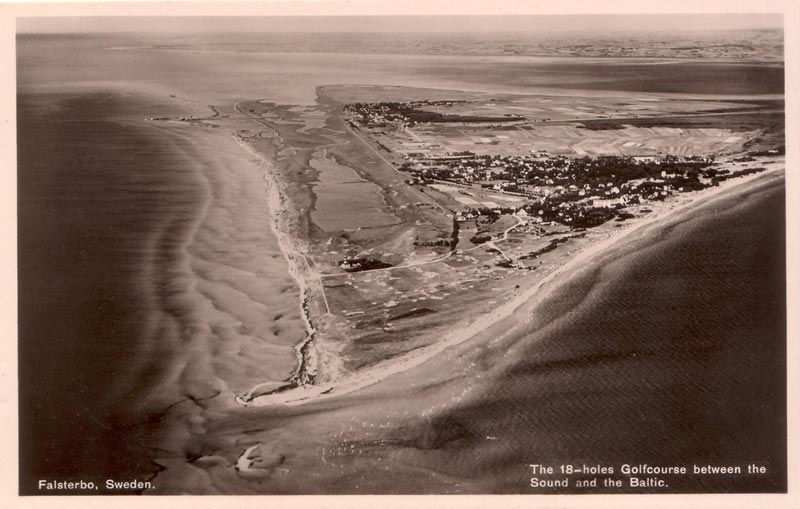
This aerial from Christoph Meister’s collection leaves no doubt as to the splendor of Falsterbo’s setting.
That impression quickly changes when standing on the first tee. Apparently, the course is famous in Sweden for its tough six hole start, which doesn’t quite come across in reading the World Atlas of Golf. Indeed, at 450 yards, the first is the longest par four on the course and when the wind comes over from Denmark and blows left to right, it is daunting with out of bounds all along the right.
A common walk path cuts across the mid section of the course, including some 220 yards from the first tee. Set in a nature preservation area, this foot path path is available to pedestrians, in particular bird watchers who come to this part of the world in the fall where this southern tip of Sweden is the last stop for certain birds migrating south. Interestingly enough, a recent two-ball had the experience of the first player teeing off to the wide open fairway with the second player unable to do so for nearly ten minutes, such was the number of people strolling along the pathway on a pretty day toward the end of summer.
This story is relayed in part to convey how interwoven the course is with its natural surrounds. Coincidentally, the foot path marks a break in the character of the course. On the north side (i.e. the farthest side from the Baltic Sea), the holes are less links like in character. Instead, holes like the fourth, fifth, and eleventh are famously threatened by water in the form of marshlands. The bunkers remain well placed but are a shade shallower as the land is flat (and the water table is quite near the surface) and the heather that comes from the sandiest soil near the sea dissipates.
On the south side of the foot path, the land is rumpled, giving the architects more opportunity to cut bunkers into landforms and thereby create some depth. Except for the risk/reward par five fifteenth and seventeenth holes, water hazards are absent and the holes rely on the native vegetation to penalize poor shots. Seen from both sides of the pathway is Falsterbo‘s famed lighthouse and the sight of it helps to knit both sections of the property nicely together.
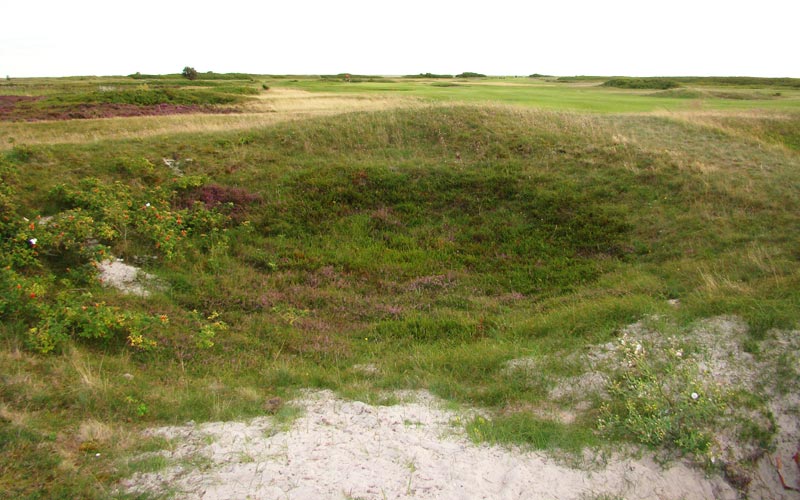
As found along the fifteenth fairway, heather and sand provide the challenge on the holes south of the foot path.
While its seaside setting is obviously the course’s lasting allure, its putting surfaces are among the best in Europe thanks to a complete re-do from 1995-2001 of the greens and their surrounds. The long time head professional Peter Chamberlain was joined by Peter Nordwall in this undertaking. In general, the greens were raised six to twenty-four inches so as to drain better and to provide short game interest. Examples abound of their work, from the double rolls found in the third green to the humps and hollows captured with the short grass to the right of the fourteenth green. Nothing dramatic was done to this epitome of low profile golf but all the little shots around the green lend the course fine golfing qualities.
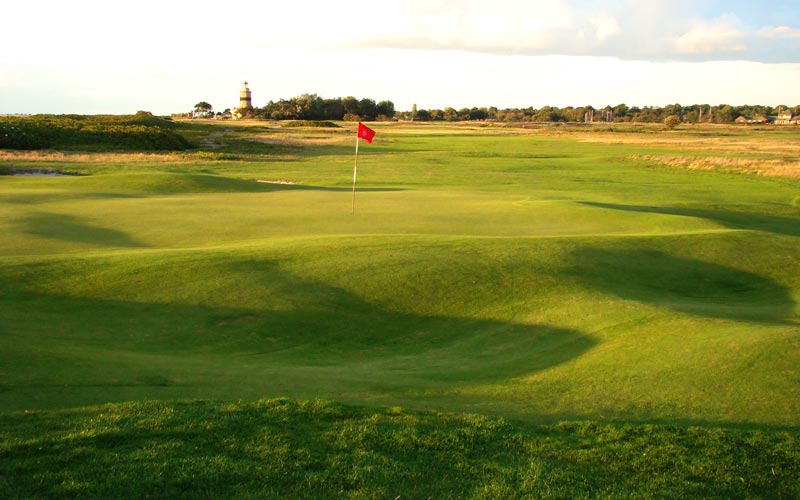
As captured in the late afternoon sun, this view back across the sixteenth green highlights the short game interest that is now prevalent at Falsterbo.
Holes to Note
Second hole, 190 yards, Dicken’s; One of the lasting pleasures in playing Falsterbo is in appreciating how little man has done to the land. Essentially, the stewards of the property have long appreciated that the setting is good enough on its own and that any signs of artificiality would only detract from it. Too bad more modern architects haven’t learned from this example. Take the Low Country in South Carolina for instance where some architects have moved tens of thousands of cubic yards of dirt right beside marshlands in a false effort to make courses standout. Ultimately, such courses only stick out as dated and painfully artificial with such designs quickly falling from favor. Mercifully, Falsterbo Golf Course is slow to change and doesn’t follow the latest design fads. The photograph below from the second tee is a text book example of how the requirement for good golf was created, all without moving much land.
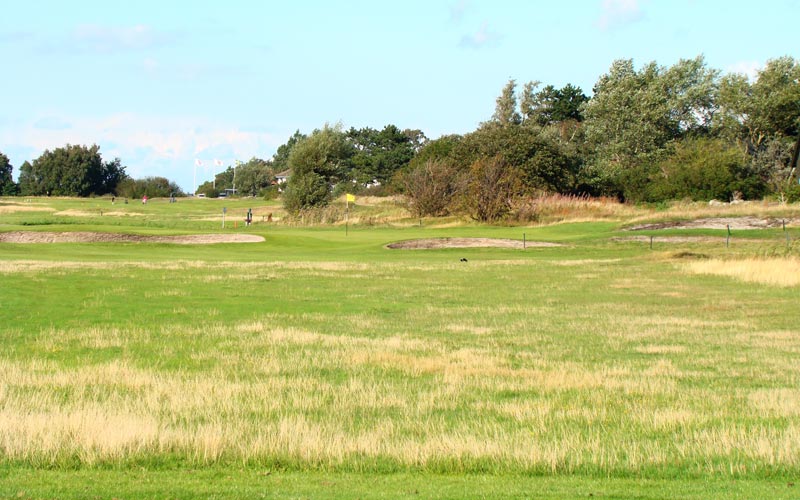
Little land was disturbed from tee to green at the second but the green is nonetheless an exacting target, thanks to four bunkers coupled with a finger of marshland to the left.
Fourth hole, 445 yards, Flommen; This is a beast of a hole, given how the marshland parallels the length of the fairway as well as how the green protrudes into it. The flatness of the surrounds provides little comfort/depth perception for the golfer’s approach. The only certainty is that there is water short, right and behind the green. Exacerbating matters is that this is the first hole played in a southerly direction, giving the golfer trepidation as to the exact strength and effect the wind will have on his approach. A two foot tall mound runs for eighty yards down the left side of the fairway and can be used to carom tee shots off it and into the center of the fairway, all the while never having flirted with the marsh to the right. All in all, a very fine strategic hole where a chip and a putt from the open front left of the green might yield a lower score over the course of a full playing season than always going for the green.

As seen from behind, the fourth green’s front left is open and is a sensible area to aim on one’s approach, given how the water wraps around the green’s other sides.
Seventh hole, 320 yards, 1911; The hole’s name is a tribute to the year that Robert Turnbull, the then head golf professional at Copenhagen Golf Club, laid out Falsterbo Golf Courses‘s original nine holes on this site. His holes played around the lighthouse in the midsection of the property and this hole is one of two remaining (the fourteenth is the other). It’s a real charmer, finishing in front of the ‘klub hus’ that was built in 1914. The only pity is that the course already has a famous half par finisher as otherwise it would be intriguing to sort out a routing that would allow this hole to be the Home hole, such are its lasting merits.
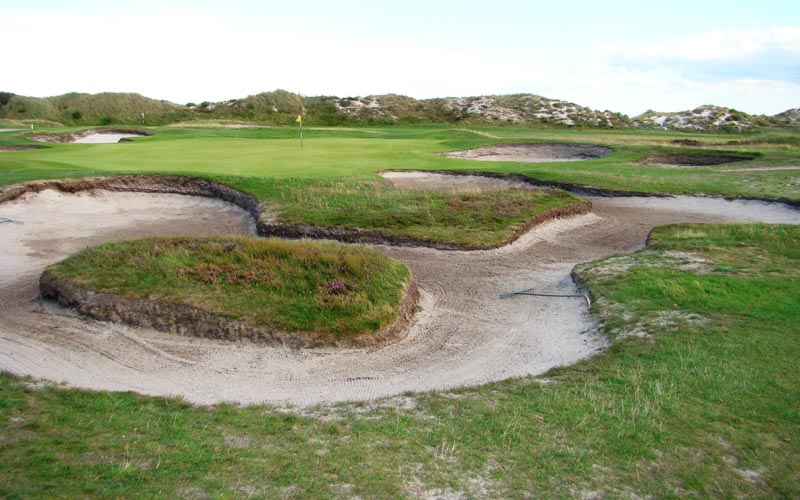
Befitting a drive and pitch hole, the green at the seventh is the most heavily bunkered one on the course and its tiny back plateau provides very challenging hole locations.
Ninth hole, 425 yards, Sydvasten; Along with the first and thirteenth holes, the ninth hole plays on both sides of the aforementioned foot path, which effectively divides the fairway into two ‘islands’. The drive must find the first one which is well guarded by nine bunkers whose wonderfully raw appearance leaves little doubt that one is playing by the sea.
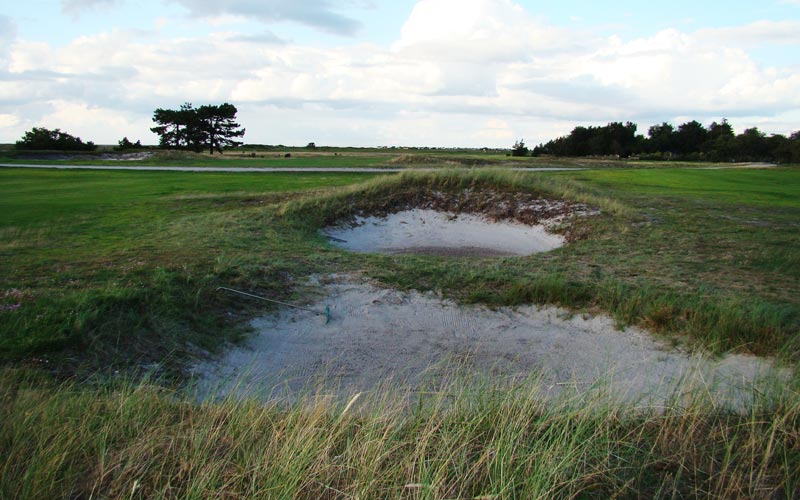
The absence of artificiality is most welcome at Falsterbo. This is how bunkers should look and be presented close to the sea.
Eleventh hole, 160 yards, Vattenhalet; One of Europe’s most famous one shot holes, the eleventh was selected for inclusion in The 500 World’s Greatest Golf Holes, published in 2000. Water holes these days are ubiquitous but history is on the side of this one. Gunner Bauer built it in 1930 as part of expanding the course from nine to eighteen holes and as such it has been unnerving golfers for decades with water tight left and right along the putting surface. Though the water is what transfixes people, this is another fine example of just how well the green project went with Nordwall and Chamberlain. A broad hog’s back ridge runs the length of the 37 yard long green, effectively dividing it into left and right sections. Good players who can shape the ball either way know exactly how to use this feature to their advantage as a draw feeds balls off it toward left hole locations and a fade does the same to right ones. In this manner, the course helps identify the better golfer as they are given ways to access certain hole locations without having to contend directly with the water hazard.
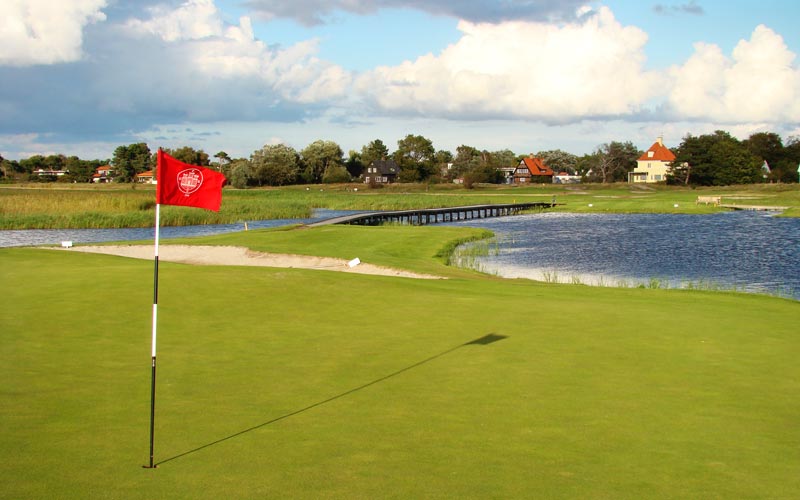
Crossing the narrow footbridge over the inlet to reach the eleventh green holds its own interest on a windy day!
Twelfth hole, 405 yards, Strandskatan; For the first time in the round, the golfer is brought in close proximity with one of the two large bodies of water that define the course. From a tee cut into a bank along the sound, the golfer surveys the split fairway before him. Which island of the fairway is best for that day is wholly dependent on the wind. As at the fifth, several bunkers dot the front of the green with the largest one being a good fifteen paces from the green’s front edge. Such forward hazards accentuate the challenge of depth perception at Falsterbo.
Fourteenth hole, 230 yards, Fyrhalet; Given that the other par three on the second nine (the eleventh) is all about aerial golf, the fourteenth proves to be the perfect compliment as it is all about the ground game. Indeed, admirers of links golf might even find this hole more compelling for that very reason. Two deep cross bunkers dominate the view from the tee. As they are thirty-five yards short of the green, dead ground is created and just where to land the ball beyond those bunkers is a perpetually intriguing mystery. As should hold true for most holes of this length on a windy site, the green is open in front and it is left up to the golfer’s imagination and talent as to how best to get his tee ball onto the putting surface. All options are open to the player , which is always a sign of fine architecture. Congratulations to Turnbull for building this one shotter in 1911 and to Bauer for incorporating it in 1930 into his eighteen hole routing.
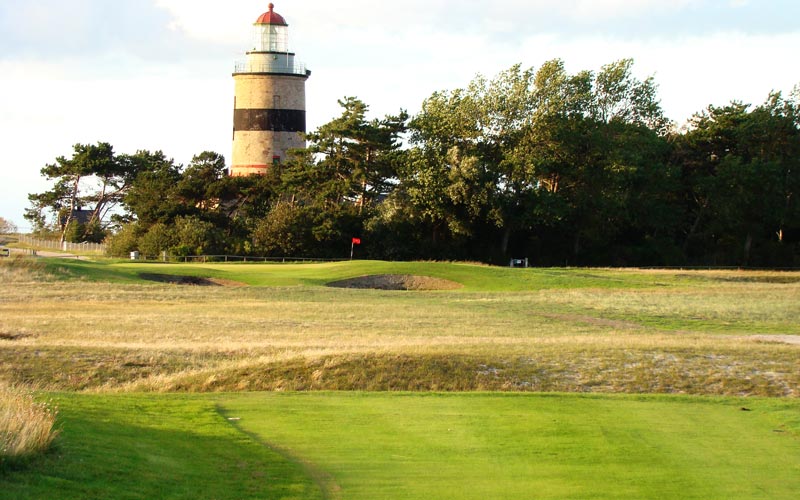
One of the two oldest holes at Falsterbo is still one of its very best. Don’t be fooled by the cross hazards that are well short of the partially hidden green.
Sixteenth hole, 390 yards, Gunnar Bauer; The course’s most memorable three hole stretch isn’t its toughest (that belongs to one of several sequences on the front) but it starts now along the banks of the Oresund. Ideally, the club would have a bit more land to stretch one or more of the final three holes but it doesn’t. Instead, the architects use differing methods here and the next hole to make them play to their maximum length. Here, there is no advantage to driving tight along the shore line and taking the direct line at the green as it is sealed off front right by a large bunker. Better to play out to the outside left of the fairway but honestly, the playing merits of the hole are overshadowed by the green’s setting. Beyond it is the tip of the club’s property where the Baltic and Oresund merge. Long views to the horizon abound with Denmark to the right and Germany to the left. In the fall and spring, golfers happily share the end of the peninsula with photographers and bird watchers. Once again, the great game of golf has taken the player to a magical spot that he would otherwise likely never have been, and he is eternally grateful.

Standing behind the sixteenth is a professional photographer taking pictures of migrating birds in late August.
Seventeenth hole, 380 yards, Nabben; This hole poses an interesting study in greed. Given its modest length and assuming a gale isn’t blowing, many a golfer can rightly stand on the tee with hopes for a par. The rub comes from those who press the issue with a bunker and small water hazard narrowing the fairway to under twenty yards of width 250-285 yards from the tee. Lay back from there and the golfer enjoys but a short iron in but great is the temptation in such a glorious setting to swing away with the driver in hopes that something equally wonderful happens. Interestingly enough, Bauer didn’t use the area of today’s sixteenth and seventeenth holes in his initial eighteen hole re-work. A local doctor by trade, where Bauer learned so much about golf course architecture is unclear but he was certainly a quick study. In 1934, four years after his formation of this eighteen hole course, this portion of the property with its ever shifting sands was deemed stable enough to place two holes. The benefits were three fold. First, by abandoning the original first and second holes, room was created for today’s large practice field. Second, the wonderful sense of being on a peninsula is at its most acute here with the corresponding feeling of remoteness having become a cornerstone of playing golf at Falsterbo. And third, the original eighteenth was played as a straightaway hole with its tee between today’s fifteenth and seventeenth greens. With the two new holes, Bauer pushed the eighteenth tee up into the dunes, thereby creating the handsome and strategic Home hole of today. Since then, little else has ever changed to the routing, a testimony to Bauer’s skill in getting the most from the relatively small site of 110 acres.
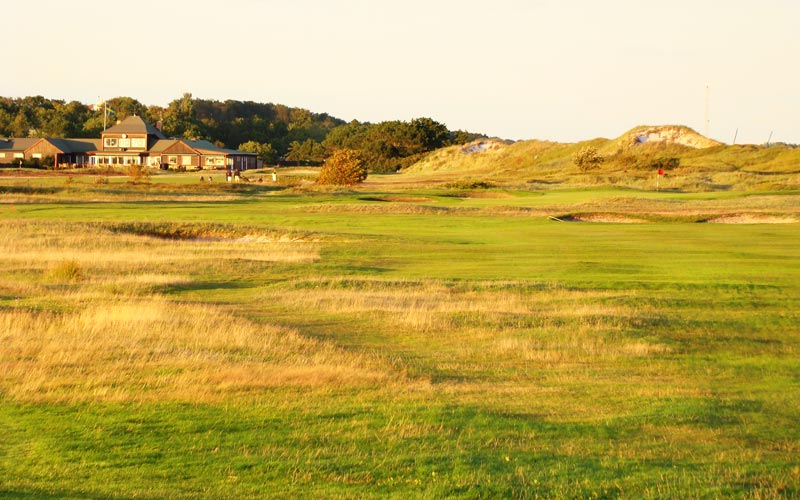
The bunker and heather ahead and the red stakes barely visible to the left suggest restraint from the seventeenth tee.
Eighteenth hole, 485 yards, Klitterna; The first three holes start on the inland border of the property and then work away from the Baltic while paralleling the Oresund from a distance. Starting at the fourth, there is a slow progression toward either the Baltic or Oresund and the golfer enthusiastically accepts the gradual building of excitement. The peak occurs either at the sixteenth green/seventeenth tee area or here at the eighteenth tee, depending on one’s preference. Certainly, nowhere is the golfer more keenly aware of the seaside landscape than along the eighteenth where a nearly twenty foot tall dune runs parallel to the length of the fairway. Anything from a ‘3’ to a ‘7’ is a distinct possible and this range of fortune helps make this among Europe’s two or three finest finishing holes, right up there with the ones at Saint Germain and Falkenstein. All the playing angles work extremely well with bunkers, heather and dunes guarding the short route home on this dogleg right. At the green, the left greenside bunker has been built up admirably and the hole locations behind it are clearly the most vexing.
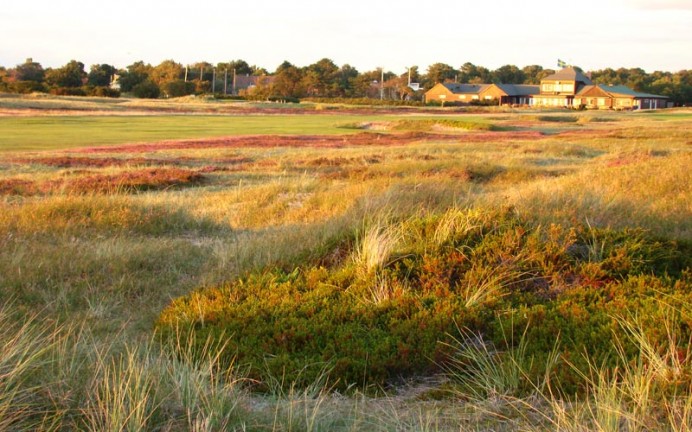
One of the game’s great finishing holes commences with this tempting drive. Each golfer must decide the prudent line for himself.

The deepest greenside bunker on the course is a function of how high the bunker wall has been built up. Today’s hole location directly behind it requires great care.
In some ways, Falsterbo with its blend of coastal holes and internal water hazards might remind the well traveled golfer of Maidstone on Long Island in the United States of America. Neither relies on length and both are crafty courses, each in their own way. Maidstone is such because of Willie Park Jr., one of the grand masters of golf course architecture. There is no such prominent design figure at Falsterbo, which makes the evolution of the course all the more remarkable. To its everlasting credit, despite having hosted famous events, Falsterbo remains unpretentious and has never fallen prey to passing fads. Its clubhouse is cozy and its course represents an uncluttered landscape firmly rooted in nature whose appeal will never diminish.
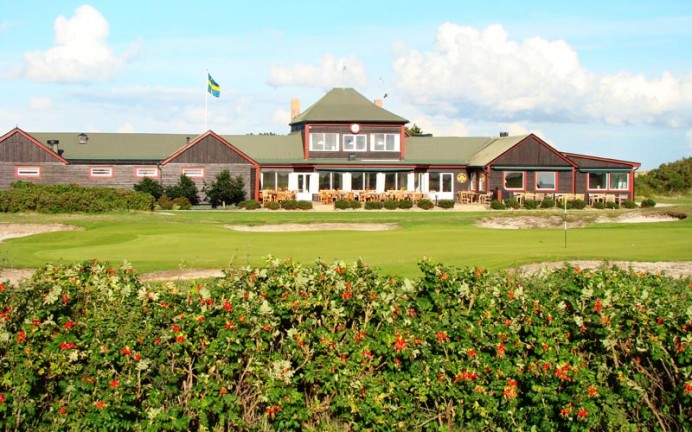
There is every reason to be hopeful that the club will continue to do as fine a job of overseeing the course for the next century as it did in the first.


